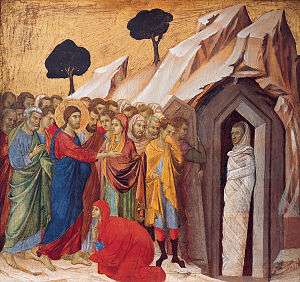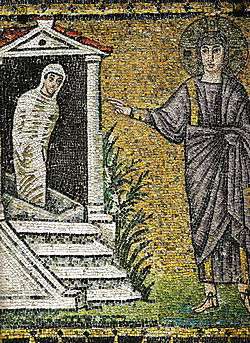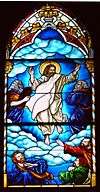Raising of Lazarus
The raising of Lazarus is a miracle of Jesus recounted only in the Gospel of John (John 11:1–44) in the New Testament in which Jesus raises Lazarus of Bethany from the dead four days after his entombment.[1][2][3] The event is said to have taken place at Bethany – today the Palestinian town of Al-Eizariya, which translates to "the place of Lazarus". In John, this is the last of the miracles that Jesus performs before the passion, crucifixion and his own resurrection.

Background
According to the Gospel of John, Lazarus was the brother of Martha and Mary of Bethany. Their family is recorded to have lived in the village of Bethany, about two miles east of Jerusalem on the southeastern slope of the Mount of Olives.
Narrative

According to John 11, Jesus receives a message that Lazarus is ill, and his two sisters are seeking Jesus' help. Jesus tells his followers: "This sickness will not end in death. No, it is for God's glory so that God's Son may be glorified through it."
Jesus then delays his departure and leaves after two days. The disciples are afraid of returning to Judea, but Jesus says: "Our friend Lazarus is asleep, but I am going to awaken him." When the apostles misunderstand, he clarifies, "Lazarus is dead, and for your sake I am glad I was not there, so that you may believe."
When they arrive in Bethany, Lazarus has been entombed for four days. Before they enter the town, Martha, Lazarus' sister, comes to meet Jesus and says to him: "if you had been here, my brother would not have died". Jesus assures Martha that her brother will rise again and states: "I am the resurrection and the life. He who believes in me will live, even though he dies; and whoever lives and believes in me will never die. Do you believe this?"
Martha affirms that she does truly believe and states, "Yes, Lord. I believe that you are the Messiah, the Son of God, who has to come into the world."

Upon entering the village, Jesus is met by Mary and the people who have come to console her. Upon seeing their grief and weeping, Jesus is deeply moved. Then, after asking where Lazarus was buried, Jesus weeps. After that, Jesus asks for the stone of the tomb to be removed, but Martha interjects that there will be a smell. Jesus responds, "Did I not tell you that if you believed, you would see the glory of God?"
They take the stone away then Jesus looks up and says: "Father, I thank you that you have heard me. I knew that you always hear me, but I said this for the benefit of the people standing here, that they may believe that you sent me."
When he said this, he then called in a loud voice, "Lazarus, come forth!" Lazarus comes out of the tomb alive, his hands and feet wrapped with strips of linen, and a cloth around his face. Jesus says to the bystanders, "Take off the grave clothes and let him go." Many of the Jews who had come to visit Mary and saw what happened believed in Jesus. Some went to the Pharisees and told them what Jesus had done.
Lazarus is mentioned again in chapter 12 of the Gospel of John. Six days before the Passover on which Jesus is crucified, Jesus returns to Bethany and Lazarus attends a supper that Martha, his sister, serves.[4] Jesus and Lazarus together attract the attention of many Jews and the narrator states that the chief priests consider having Lazarus put to death because so many people have come to believe in Jesus on account of his raising Lazarus.
Interpretation
Gospel narrative
The miracle of the raising of Lazarus is the climax of John's "signs". It explains the crowds seeking Jesus on Palm Sunday, and leads directly to the decision of Caiaphas and the Sanhedrin to plan to kill Jesus. Theologians Moloney and Harrington view the raising of Lazarus as a "pivotal miracle" which starts the chain of events that leads to the Crucifixion of Jesus. They consider it as a "resurrection that will lead to death", in that the raising of Lazarus will lead to the death of Jesus, the Son of God, in Jerusalem which will reveal the Glory of God.[5]
Theology
The Catechism of the Catholic Church states that the miracle performed by Jesus returned Lazarus to ordinary earthly life as with the son of the widow of Nain and Jairus' daughter and that Lazarus and the others who were raised from the dead would later die again.[6] The Russian Orthodox Church's Catechism of St. Philaret writes that among the miracles performed by Jesus was the raising of Lazarus from the dead on the fourth day after Lazarus' death.[7] In the Southern Baptist Convention's 2014 resolution On The Sufficiency Of Scripture Regarding The Afterlife, the raising of Lazarus is noted among the Bible's, "explicit accounts of persons raised from the dead", and comments on those raisings that, "in God’s perfect revelatory wisdom, He has not given us any report of their individual experience in the afterlife".[8]
John Calvin notes that, "not only did Christ give a remarkable proof of his Divine power in raising Lazarus, but he likewise placed before our eyes a lively image of our future resurrection."[9] French Protestant minister Jakob Abbadie wrote that Jesus had intentionally delayed his return to Bethany for, "four days, that it might not be said, he [Lazarus] was not really dead."[10] In 2008, Pope Benedict XVI said that the Gospel story of the raising of Lazarus, "shows Christ’s absolute power over life and death and reveals His nature as true man and true God" and that "Jesus' lordship over death does not prevent him from showing sincere compassion over the pain of this separation."[11]
Matthew Poole and others saw Lazarus' ability to move despite having his hands and feet wrapped together as a second miracle, but Charles Ellicott disputed that Lazarus' movement would have been restricted by his burial garments.[12][13]
Criticism
Exegesis in the Interpreter's Bible comparing the raising of Lazarus to other resurrections in the Bible comments that, "The difference between revival immediately after death, and resurrection after four days, is so great as to raise doubts about the historicity of this story, especially in view of the unimaginable details in vs. 44. Yet there are features in this story which have the marks of verisimilitude."[14] In The God Delusion, Richard Dawkins, outspoken atheist, writes that, in principle, the question of whether or not Jesus raised Lazarus from the dead has a strictly scientific answer, whether or not that answer can be discovered in practice.[15] In 2013, Dawkins wrote that Jesus did not raise Lazarus from the dead.[16] In the 19th century, agnostic speaker Robert G. Ingersoll wrote that, if Lazarus had in fact died, potentially participating in an afterlife, and then subsequently had been resurrected, the experiences Lazarus could have shared with others would likely have been more interesting than everything else in the New Testament, would have drawn widespread attention to Lazarus during his lifetime and might have made him less afraid than others that did not have his experience when Lazarus approached death for a second time.[17] Deist Lysander Spooner wrote that it was unusual that the Synoptic Gospels (Matthew, Mark and Luke) do not mention the miracle of the raising of Lazarus, which seems as if it could have been a demonstration of the miraculous powers of Jesus. The Synoptic Gospels do include passages concerning the activities of the sisters of Lazarus but fail to mention their brother's resurrection. Spooner wrote that this seemed to indicate that the author of the Gospel of John, "was actually dishonest, or that he took up, believed and recorded a flying story, which an occurrence of some kind had given rise to, but which was without any foundation in truth."[18] In the Jefferson Bible, which removes supernatural events from the Bible while attempting to retain information about the life and morals of Jesus, Thomas Jefferson chose not to include the raising of Lazarus.[19]
Art
The Raising of Lazarus is one of the most popular artistic themes in the Catacombs of Rome including examples from the 2nd century.[20]
Cultural references
The story of Lazarus is frequently referenced in culture. Examples include:
- In the 1851 novel Moby-Dick by Herman Melville, after writing his will and testament for the fourth time, Ishmael remarks that, "all the days I should now live would be as good as the days that Lazarus lived after his resurrection; a supplementary clean gain of so many months or weeks as the case might be."[21][22]
- In Fyodor Dostoevsky's 1866 novel Crime and Punishment the murderer Raskolnikov asks the prostitute Sonia to read him this section of the Gospel.[23]
- In two short stories written by Mark Twain and posthumously published in 1972, a lawyer argues that Lazarus' heirs had an indisputable claim to any property the resurrected Lazarus had owned before his death.[24][22]
- In the 2010 book The Big Questions: A Short Introduction to Philosophy written by American professors of philosophy Kathleen Higgins and Robert C. Solomon, at the end of Chapter 5, The Search for Truth, readers are asked to consider: "Could a scientist give an adequate account of the biblical story of the raising of Lazarus?"[25]
- In the 2014 science fiction movie Interstellar, a fictional space program carries the name Lazarus, reflecting mankind's metaphorical resurrection through space exploration.
- DC comics references the story of Lazarus with the "Lazarus pits" used to restore life and vitality, or even grant immortality to those who bathe in their waters.
See also
- Corpse decomposition
- Lazarus Saturday
- Ministry of Jesus
- Seven signs in the Gospel of John
| Wikimedia Commons has media related to Resurrection of Lazarus. |
References
- "Lazarus". Encyclopaedia Britannica. Retrieved 19 March 2020.
When Lazarus died, he was raised by Jesus from the dead after he had been entombed for four days. This miraculous raising of Lazarus from the dead inspired many Jews to believe in Jesus as the Christ.
- "John 11:1-46". Biblegateway. NIV.
- Clowes, John (1817). The Miracles of Jesus Christ. Manchester, UK. p. 274.
- John 12:2
- Francis J. Moloney, Daniel J. Harrington, 1998 The Gospel of John Liturgical Press ISBN 0-8146-5806-7 p. 325
- "Paragraph 2. On the Third Day He Rose from the Dead". Catechism of the Catholic Church. Retrieved 27 February 2020.
640{...}Jesus had not simply returned to earthly life as had been the case with Lazarus.{...}
{...}
646 Christ's Resurrection was not a return to earthly life, as was the case with the raisings from the dead that he had performed before Easter: Jairus' daughter, the young man of Naim, Lazarus. These actions were miraculous events, but the persons miraculously raised returned by Jesus' power to ordinary earthly life. At some particular moment they would die again. Christ's Resurrection is essentially different. In his risen body he passes from the state of death to another life beyond time and space.{...} - "The Longer Catechism of The Orthodox, Catholic, Eastern Church". Retrieved 27 February 2020.
He raised the dead: the son of the widow of Nain, the daughter of Jairus, and Lazarus on the fourth day after his death.
- "On The Sufficiency Of Scripture Regarding The Afterlife". Baltimore: Southern Baptist Convention. 2014. Retrieved 10 March 2020.
WHEREAS, Though the Scriptures include explicit accounts of persons raised from the dead, such as Jairus’ daughter, the widow of Nain’s son, and Lazarus, in God’s perfect revelatory wisdom, He has not given us any report of their individual experience in the afterlife (Deuteronomy 29:29; Mark 5:21–43; Luke 7:11–17; John 11:35–44);
- "John 11 Calvin's Commentaries". Biblehub.com. Retrieved 2018-04-16.
- Jakob Abbadie (1697). A Vindication of the Truth of Christian Religion, against the objections of all Modern Opposers. 2. Translated by Henry Lussan. London – via Google Books.
- "Pope Benedict: resurrection of Lazarus reveals Christ's power over life and death". Catholic News Agency. 9 March 2008. Retrieved 27 February 2020.
- "John 11". Retrieved 19 March 2020 – via BibleHub.com.
bound hand and foot: and here is a second miracle, that one so wrapped and bound up should be able to move and come forth.
(Matthew Poole) - "John 11". Retrieved 19 March 2020 – via BibleHub.com.
many of the older expositors regard the power to move, when bound hand and foot, as itself a miracle. But this seems not to be necessary, and if not necessary, is not to be resorted to. (Comp. Note on John 6:21.) The grave-clothes may have been bound round the limbs separately
(Charles Ellicott) - Interpreter's Bible. 8. Abingdon Press. 1953. pp. 648 & 649 – via Internet Archive.
- Richard Dawkins. "The God Delusion". p. 83 – via Google Books.
- ""Did Jesus exist?" Who cares? "Did Jesus lack a father? Raise Lazarus? Walk on water? Resurrect?" I care, and the answer is no in all cases". Twitter. 11 June 2013. Retrieved 19 March 2020.
- Robert G. Ingersoll (1892). "Prose-Poems and Selection from the Writings and Sayings of Robert G. Ingersoll" (5 ed.). New York: C. P. Farrell. p. 84 – via Internet Archive.
It seems to me that he would have been an object of great interest.{...}Thousands would have inquired of him about the other world;{...}His experience would have been vastly more interesting than everything else in the New Testament.{...}When he came to die again, people would have said: "He is not afraid; he has had experience; he knows what death is."
- The Deist's Reply to the Alleged Supernatural Evidences of Christianity. Boston. 1836. p. 34 – via Internet Archive.
- Barbara Cawthorne Crafton (2018). Come Here, Jesus. Church Publishing. p. 99 – via Google Books.
In Jefferson's Bible,{...}Jesus does not raise Lazarus from the dead, nor does he raise anybody else.
- Clark Diven Lamberton (1905). Themes from St. John's gospel in early Roman catacomb painting. p. 58.
- Herman Melville. "Moby-Dick". p. 288 – via Internet Archive.
- David Lyle Jeffrey. A Dictionary of Biblical Tradition in English Literature. p. 440 – via Google Books.
Mark Twain, who refers ironically to the legal implications of Lazarus's resurrection.
- Rutledge, Fleming. "The Raising of Lazarus", Generous Orthodoxy, 1980
- Mark Twain's Fables of Man (1972). Edited by John S. Tuckey. Berkeley, University of California Press, ISBN 0-520-02039-1 pp.65-66, 74. "the lawyer said that if Lazarus left any property behind him he most certainly found himself penniless when he was raised from the dead; that if there was any dispute between him and his heirs, the law upheld the latter."
- The Big Questions: A Short Introduction to Philosophy. 2010 – via Google Books.
External links
- Lazarus Is Resurrected (from Jehovah's Witnesses Official Website)
- Lazarus Is Raised from the Dead (from The Church of Jesus Christ of Latter-day Saints)
- Lazarus Reanimated (from the Brick Testament)
- The Raising of Lazarus and the Bodily Resurrection - Dr. Charles P. Baylis (from Dallas Theological Seminary)
